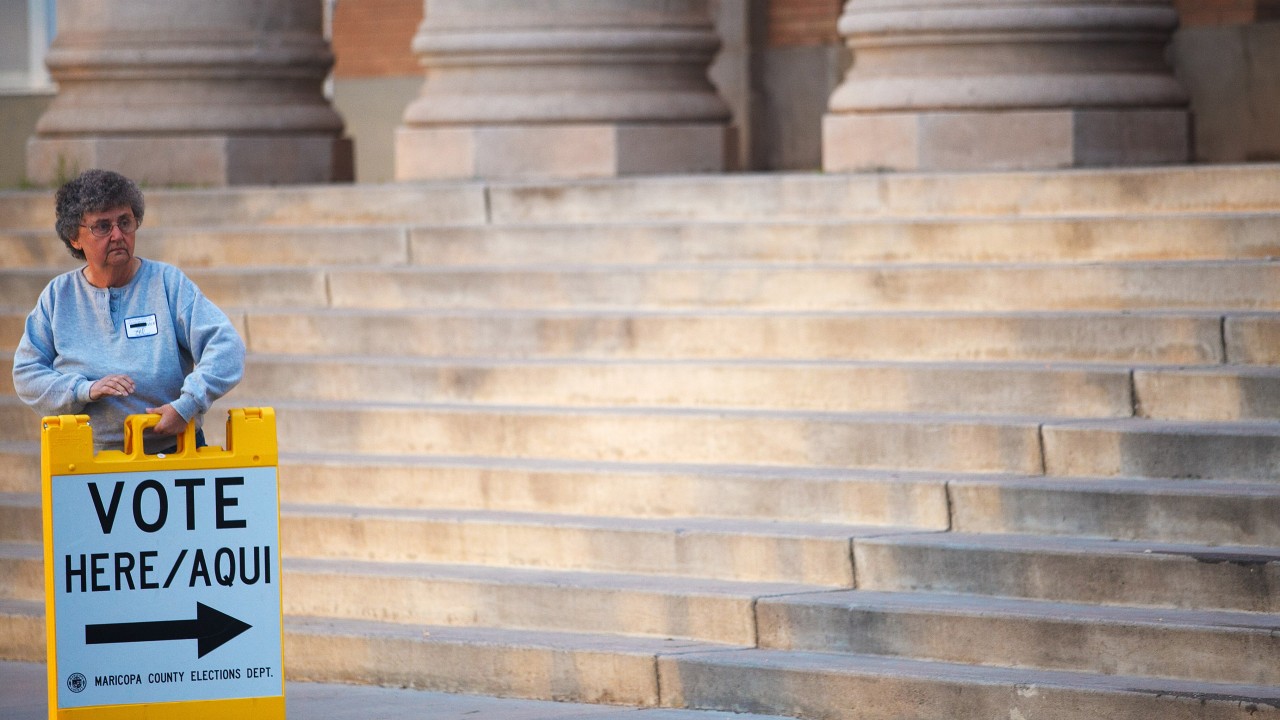
Election day volunteer Vicki Groff places a sign to direct voters to a polling station at Kenilworth School in Phoenix, Arizona, in February 2012. (Photo by Jonathan Gibby/Getty Images)
This post originally appeared at The Nation.
Aracely Calderon, a naturalized citizen from Guatemala, arrived just before the polls closed at 7 p.m. in downtown Phoenix to vote in Arizona’s primary last night. “When Calderon arrived, the line spanned more than 700 people and almost 4 blocks,” the Arizona Republic reported. She waited in line for five hours, becoming the last voter in the state to cast a ballot at 12:12 a.m. “I’m here to exercise my right to vote,” she said shortly before midnight, explaining why she stayed in line.
But many other Arizonans left the polls in disgust. The lines were so long because election officials in Phoenix’s Maricopa County, the largest in the state, reduced the number of polling places by 70 percent from 2012 to 2016, from 200 to just 60 — one polling place per every 21,000 voters.
Election officials said they reduced the number of polling sites to save money — an ill-conceived decision that severely inconvenienced hundreds of thousands of voters. Previously, Maricopa County would have needed to receive federal approval for reducing the number of polling sites, because Arizona was one of 16 states where jurisdictions with a long history of discrimination had to submit their voting changes under Section 5 of the Voting Rights Act. This type of change would very likely have been blocked since minorities comprise 40 percent of Maricopa County’s population and reducing the number of polling places would have left minority voters worse off. Section 5 blocked 22 voting changes from taking effect in Arizona since the state was covered under the VRA in 1975 for discriminating against Hispanic and Native American voters.
But after the Supreme Court gutted the VRA in 2013, Arizona could make election changes without federal oversight. The long lines in Maricopa County last night were the latest example of the disastrous consequences of that decision.
“We are outraged at long lines for Arizona primary,” the Arizona Republic wrote in a sharply worded editorial. The paper told stories of voters who left without casting a ballot because of the long lines.
Here’s what one Maricopa County voter wrote to us:
“I literally went to multiple polling places, a total of FIVE separate times, only to find that the 1 hour wait (which I didn’t have time for this morning) only increased as the day went on. Eventually, I gave up at 6:40 p.m. when I saw the line at its longest, at least 2-3 hours. This was the first time in my life I genuinely felt disenfranchised.”
“Disenfranchised” was a flash word on Tuesday. Many voters used it.
This impacted voters across the county, but some more than others. There were predominantly Latino areas in Maricopa County with no polling places. “It is no coincidence many poor and predominantly Latino areas didn’t get a polling place,” wrote Arizona Republic columnist Elvia Diaz.
The 2016 election is the first in 50 years without the full protections of the VRA. Widespread voting problems during the primaries in states like Arizona and North Carolina are a disturbing preview of what could happen in November.




